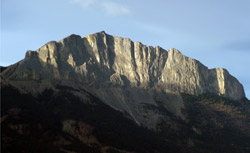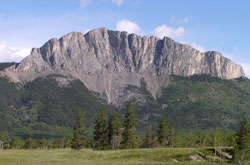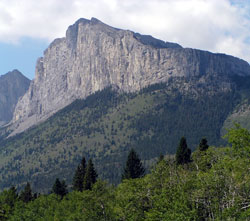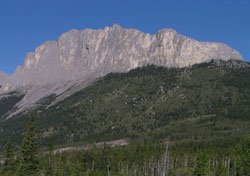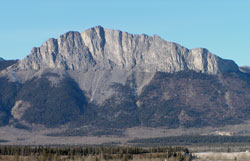
Photo: Looking northwest to Yamnuska [Mount Laurie (?y?mnathka)] from the Bow Valley from the Trans-Canada Highway
Yamnuska
- 2240 m (7,349ft)
Located on the north side of the Bow River Valley southwest of Old Fort Creek
Province: Alberta
Headwater: Bow
Major Valley: Bow
Visible from Highway: 1
*Please note that "Yamnuska" is an unofficial name as the mountain was officially named Mount Laurie in 1961. The name is then followed in brackest by the native name for the mountain which translates as "wall of stone". A duplicate entry in the database has been entered because the name "Yamnuska" remains in common usage. Located on the north side of the Bow River, Mount Laurie is the most easterly mountain in the valley and features a very steep, often vertical and overhanging south cliff 360 metres in height and almost two kilometres in width. Geologically, the mountain is noteworthy because of the clear view of the McConnell Thrust Fault (see Mount McConnell) that has forced 600 million year old Paleozoic limestone over 100 million year old Mesozoic rocks. The harder limestone forms the cliff and the softer shales of the Mesozoic form the lower layers. Generally sound rock combined with easy access from Calgary and a southern exposure which makes it climbable when most other mountains are not in condition has made the mountain very popular with serious, technical climbers. The rock climbing history on Mount Laurie began in the 1950's when guides Hans Gmoser and Leo Grillmair arrived from Europe and put up the "Grillmair Chimney" route. There are now over one hundred recognized routes on the cliff face. Yamnuska is the setting for Ben Gadd's highly regarded novel, "Raven's End." The story follows the lives of a group of ravens that reside on Yamnuska. One of the ravens, Colin, ventures off and travels through the Rockies searching for the mythical "Mountain of Feathers." Ben weaves his extensive knowledge of the Rockies into this wonderful tale. Laurie Skreslet, the first Canadian to summit Mount Everest, has written that Yamnuska is a very special mountain to him, "When I'm away from home, in a foreign land, and I'm run down and hurting, sometimes I lean back and close my eyes and find myself drifting back to Yamnuska. I can feel the wind in that area and hear the trees when the wind passes through them and they speak. I can taste the water that comes from Yamnuska's underground streams, and I feel the accomplishment, fear, and deep satisfaction that I have experienced in 32 years of climbing on that mountain. I've been to a lot of places in this world, but none of them feel like home the way that mountain does." Until 1961 the mountain was known as Yamnuska which is derived from the Stoney word from the Stoney "Iyamnathka" that describes steep cliffs or "the flat faced mountain." It was renamed at the request of the Stoneys in honour of the founder of the Indian Association of Alberta, John Laurie. John Laurie (1899-1959) was an educator and political activist. Born in Ayr, Ontario, he was educated at Galt Collegiate Institute and the University of Toronto. He came west in 1920 and attended Calgary Normal School. After teaching in several rural communities, he taught at Western Canada College and later at Crescent Heights High School. In 1939 he became interested in the problems facing Alberta Indians and for the next twenty years espoused Indian causes and assisted many Indian youth in furthering their education. He acted as Secretary of the Indian Association of Alberta from 1944-1956, utilizing much of his spare time promoting the causes of Alberta Indians. In the mid-1950?s, his health failed and he resigned as a teacher in 1956. From 1955 until 1959 he worked for the Glenbow Foundation compiling information about the Stoneys. John Laurie received an honourary doctorate from the University of Alberta in 1956 and, in the same year, was selected as Calgary's outstanding citizen of the year. The following inscription appears on a large rock on the Stoney Reserve beneath the mountain: "A good friend to the Indians who taught them to preserve their culture and their treaty rights, and helped unite the nine tribes of our province into the Indian Association of Alberta. His efforts improved the condition of the Indian, and created friendship, equality, and understanding between Alberta Indians and other citizens. Over the boundaries of colour and race swept the will of the Great Spirit." Yamnuska is the only mountain in the Canadian Rockies with two books written about it. "The Yam" was written by Chic Scott, Ben Gadd, and Dave Dornien. "Yamnuska Rock," by Andy Genereux, describes 115 climbing routes on the mountain. Both are available through Rocky Mountain Books. For a panoramic view from the summit of Yamnuska visit www.canadasmountains.com.

